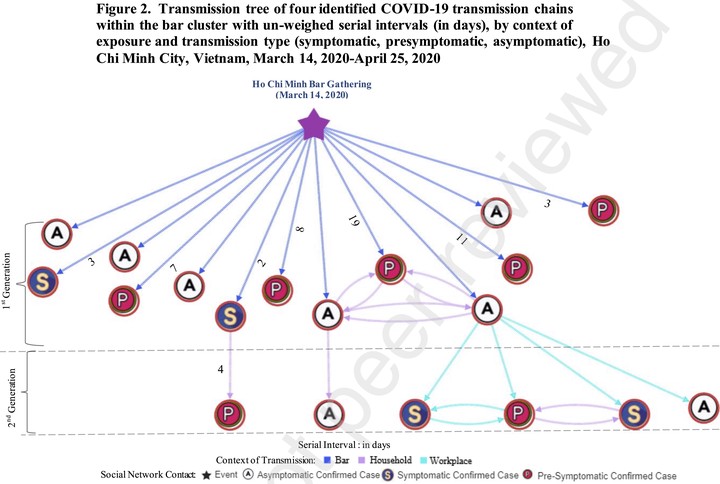Estimating asymptomatic and presymptomatic transmission of 2019 novel coronavirus (COVID-19) infection: a cohort study in Ho Chi Minh City, Vietnam

Abstract
Background: The rapid increase in the number of coronavirus disease 2019 (COVID-19) cases worldwide has raised concerns of viral transmission from individuals displaying no or delayed clinical symptoms. We quantified the transmission potential of asymptomatic, presymptomatic and symptomatic cases using surveillance data from a bar gathering in Ho Chi Minh City, Vietnam.
Methods: Between March 14 and April 25, 2020, we collected demographic, clinical and laboratory information of all COVID-19 confirmed cases and contacts from a bar gathering. We applied a Bayesian framework to estimate the proportions of asymptomatic, presymptomatic and symptomatic cases and transmissions with posterior modes and 90% credible intervals (CrI). Using Go.Data, we mapped chains of transmission and estimated the basic reproduction number (R_0).
Findings: Of the 298 individuals attending the bar gathering on March 14, 2020, 13 tested positive for SARS-CoV-2. Another 6 tested positive from 4466 contacts further traced. The proportions asymptomatic, presymptomatic, and symptomatic were 0.43 (90% CrI 0.26−0.60), 0·35 (90% CrI 0.20−0.52) and 0.22 (90% CrI 0.09−0.37), respectively. The proportion of asymptomatic, presymptomatic and symptomatic transmissions were 0.35 (90% CrI 0.16−0.68), 0.53 (90% CrI 0.21−0.77), and 0.04 (90% CrI 0.02−0.26), respectively. The cluster-specific R_0 was 2.52 (90% CrI 1.65−4.88). The bar constituted 68%, workplace 21%, and household 11% of transmissions.
Interpretations: We demonstrated using statistical models on surveillance data that high of asymptomatic and presymptomatic transmission of COVID-19 occurred in a Vietnam cluster. Detecting and isolating presymptomatic and asymptomatic cases will be an important control measure as movement restrictions are lifted.